Bikepacking-specific bags are part of what differentiates bikepacking from bike touring. The minimalist bags allow you to carry essential gear for your trip while putting an emphasis on keeping your bike light and nimble so it will handle well on off-pavement terrain.
When you're loading up for a bikepacking trip, it's perfectly fine to pack your stuff into a backpack, and if you have a rack and panniers at home, you can use those, too. However, after a few trips, you may see the value in using lighter, more-streamlined bikepacking bags, especially if you like to ride narrow singletrack trails where a wide load can get hung up on obstacles.
How to Choose Bikepacking Bags
1. Start with a seat pack, handlebar pack and bike frame pack: These bags make up the standard storage system for most bikepackers. You can use some or all of these, depending on where you're going and how much gear you're carrying.
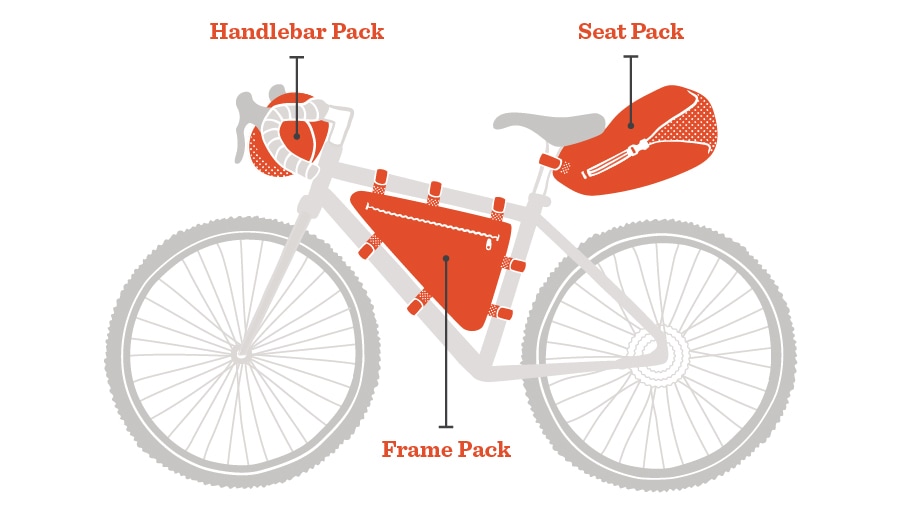
2. Add other storage options as needed: Stem bags, top tube bags, cargo cages and cycling backpacks extend your packing options (and bottle cages are must-haves for carrying water).
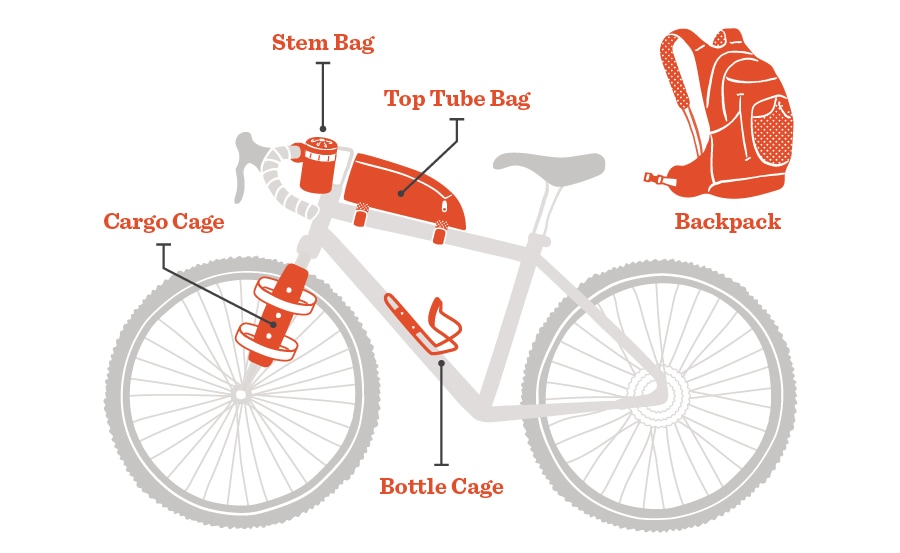
Seat Packs
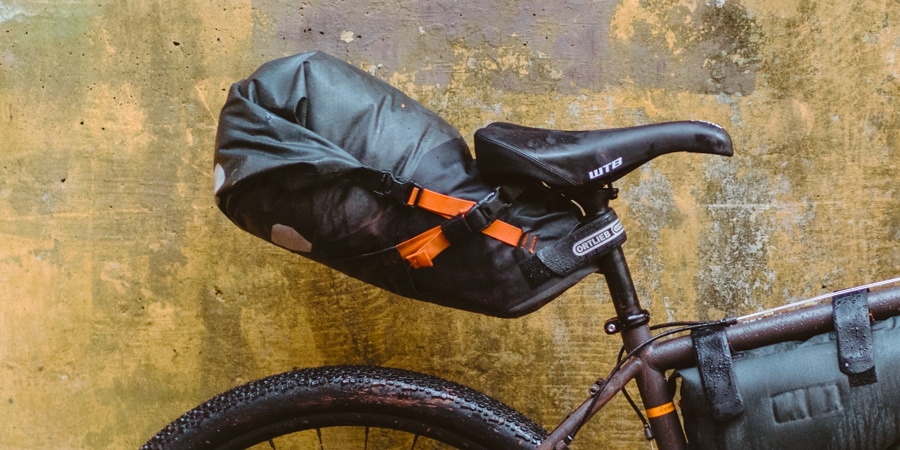
If you only get one bag, get a seat pack. It's a key piece of equipment in bikepacking and offers a convenient place for stowing bulky, lightweight items, like a sleeping bag and puffy coat. A seat pack is way more streamlined than a rack and panniers, which makes riding narrow, technical trails possible.
When choosing a seat pack for bikepacking, consider:
- Volume: Seat packs are available in a variety of sizes, usually from about 5 liters to 15 liters.
- Water resistance: To keep your gear and clothing dry, you'll want your seat pack to have a level of water resistance. Some packs are full-on waterproof, while others have waterproof fabric but not seams.
- Sway: Seat bags can sway a bit from side to side if not secured and packed properly, which you may feel while riding. To minimize this, examine how secure the attachment is to your bike and try to put the heaviest items closest to the seat post.
Handlebar Bags
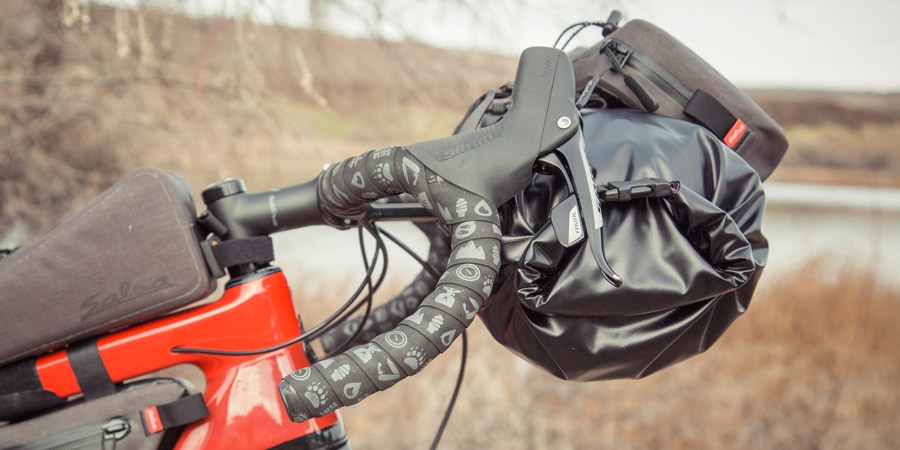
A handlebar pack is a good place for stowing clothing in a dry sack or attaching cylindrical items, like a tent.
There are two main styles of handlebar packs for bikpacking:
- One-piece bags: These generally have built-in hardware for securing the bag to your bike. These bags are often sleek and easy to attach.
- Two-piece harness systems: These use a harness that attaches to your handlebar. The harness then secures a bag made specifically for the system or individual items, like a tent or sleeping bag. The two-piece system can be a bit more versatile and ideal for holding really large items.
Whichever style you choose, make sure the fit is right. Pay attention to how much room you have between your front tire and the bottom of the pack. If space is limited and you're riding a bike with a suspension fork, the tire may rub on the bag when your fork compresses. Also, if you have a bike with drop bars, side-to-side space is generally more limited, but there are some packs designed specifically for use with drop bars.
Bike Frame Packs
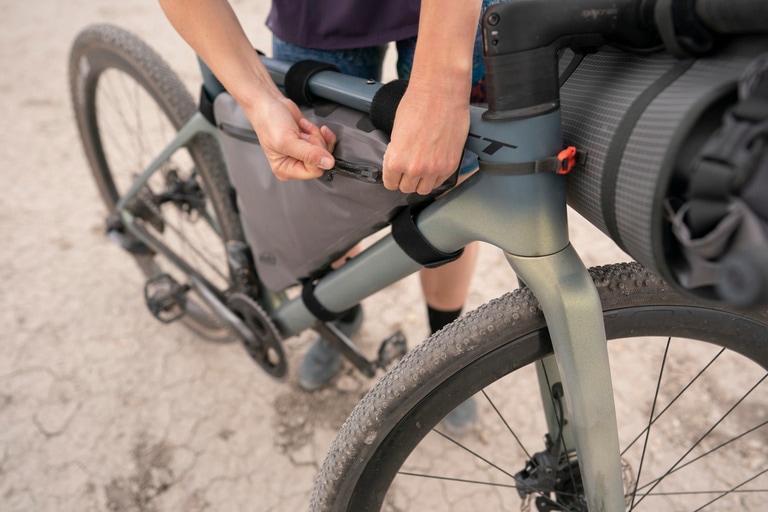
A frame pack is designed to fit in the triangle formed by the top tube, seat tube and down tube of your bike. In order to keep your bike's center of gravity low, a frame pack is a great place for stowing heavy items.
When choosing a frame pack for bikepacking, consider:
- Fit: You want to find a frame pack that fits your bike well. You may be able to find one made specifically for your bike, or there are universal ones that will likely work. Pay attention to where the attachment straps are and how they align with your bike's cables. A pack that fits well will be nice and secure with minimal movement while you're pedaling.
- Size/volume: There are frame packs that take up nearly the entire triangle, or you can get one that only partially fills it. Larger packs can hold more, but they often don't work well with rear suspension, and they will likely prevent you from mounting bottle cages inside the triangle. Choose the size that best fits your bike and provides enough space for packing.
- Organization pockets: Some frame bags have multiple pockets, which can make stowing and finding items easier.
Other Storage Solutions
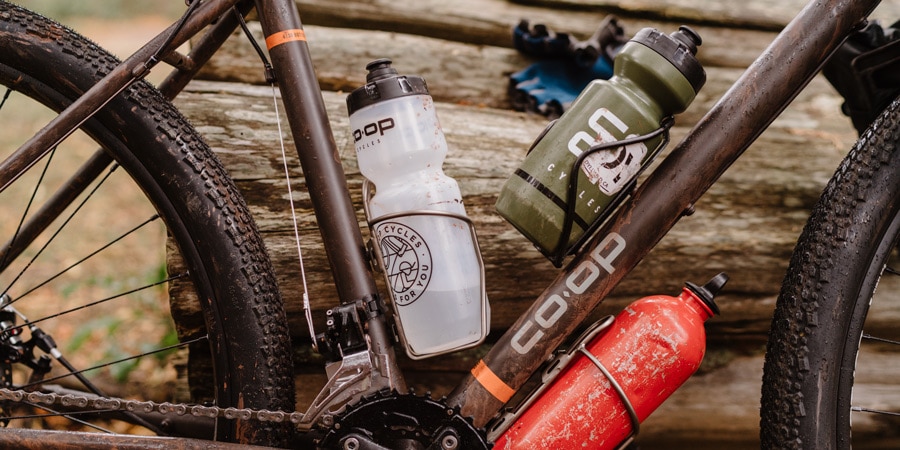
Depending on the length of your trip and what gear you're bringing along, you may need more space than a seat pack, handlebar pack and frame pack provide. Also, it can be tough to get in and out of those packs for a quick snack or to grab your camera while you're on the go. This is where options like stem bags, top tube bags, bottle cages, cargo cages and backpacks come in.
Additional storage options for bikepacking:
- Stem bags: These small pouches attach behind your handlebar, usually to the handlebar and/or stem with a couple hook-and-loop strips. They give you a convenient place for stashing and accessing small items, like snacks, water, a phone or sunglasses while you're riding.
- Top tube bags: Usually a tad bigger than stem bags, top tube bags attach to the top of your top tube, behind your head tube or in front of your seat post. Like a stem bag, they are great for holding small items that you want access to while pedaling. When shopping, consider things like storage volume and how the bag will fit on your bike. Also, make sure the bag won't interfere with your pedaling at all.
- Bottle cages: Standard bottle cages are nothing new, but they are key for carrying water while bikepacking. They attach to threaded fittings on the seat tube and/or down tube on most bikes, giving you a place to put standard-size bike bottles. Some bikes designed specifically for bikepacking will have fittings on the fork and/or underside of the down tube as well. If your bike doesn't have these, you can secure a cage with hose clamps from the hardware store.
- Cargo cages: These look a lot like bottle cages, but are designed to carry gear or larger water bottles instead of standard bike bottles. They are often meant to go on your bike's fork, but some can go on the down tube and/or seat tube. You'll want to check how the cage attaches and make sure it will work with your bike. Some cargo cages require a 3-hole mounting pattern, which you can find on some forks designed for bikepacking.
- Backpacks: While many bikepackers try to avoid riding with a backpack, sometimes it's necessary in order to carry all your essential gear. For your comfort, try to not put a ton of weight on your back. Some riders will only carry a hydration reservoir in a pack, while others will stuff other items in there, like clothing, a sleeping pad or even a tent. As a rough guideline, to maintain comfort while riding, try to use a lightweight pack that's 20-liters or smaller.
These are just some of the storage solutions available; bikepacking pack makers are frequently coming up with new, innovative ways of storing gear. Search around for what's out there and you mind find another type of pack to solve all your storage woes.

